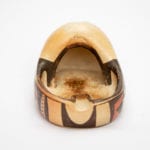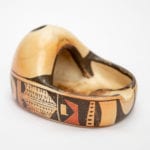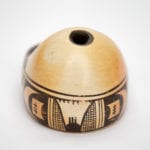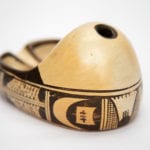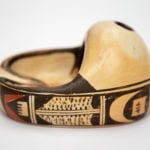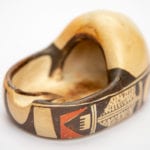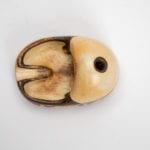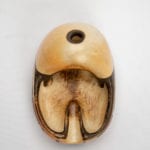This is a simple tourist kitsch by an accomplished potter who could produce pots of high artistic quality. Like the cowboy ashtray by Nampeyo (also painted by Fannie, 2011-32), I include this pot in the collection to demonstrate the range of production required of even exceptional potters. Masterpiece pots might command big prices, but tourists want smaller cute pots that they can tuck into a suitcase. It’s this sort of pottery trinket that helps provide a steady income.
Pot 2017-12 is in the general form of a “horno” oven that the Spanish introduced to southwest pueblos in the 1500’s. Here the domed form has been modified to be the roof over an ashtray, the rim facing the horno is sloped to hold a cigarette. Smoke from the embers is captured by the dome and funneled through a hole in the top. Staining indicates pot 2017-12 well-served its purpose.
In spite of it’s kitch form, pot 2017-12 is exceptionally well-made. The base is quite thick and the walls are substantial, making the pot heavier than one would expect for its small size. The dome and particularly the bottom are blushed from the outdoor firing. The pot is finely polished. Held in the hands with eyes closed, the weight, shape and finishing encourage fondling.
Fannie intended that both sides of the ashtray would have the same design, but there is a minor variation between the two sides, a difference that would bother neither Fannie or the tourist who carried ithe trinket home. Directly under the rim slot that holds a cigarette, there is a black “U-shaped” element that mirrors the wall above. On both sides there is then an unpainted area followed by a black section with imbeded designs. On one side the black section has a straight edge and the first design is a red crown formed by two touching scalene triangles. Between the points of this crown is an unpainted square with five lines drawn parallel to the base, followed by an unpainted vertical strip with a central black line, forming a two-lane highway. On the second side this section is somewhat different. One edge of the black area is convex with the second edge straight. Then a vertical gap in the paint contains six dots, followed by the familiar red crown. In contrast to the first side, the unpainted square between the horns is left empty. A narrow unpainted gap then separates this section from the rest of the design. Except for one even more minor detail, the rest of the design is the same on both sides of the ashtray.
The central rectangle of the design is a stippled image roughly in the shape of an arrowhead pointed toward the rear of the ashtray. The residual four corners of this rectangle are black. Running the length of the arrowhead is a horizontal unpainted strip painted with four parallel lines forming a three-lane “highway.” A similar vertical highway marks the end of the rectangle, followed by a black rectangle with two imbeded unpainted forms. The first is a crescent moon; the second square with one concave vertical edge. In the center of this distorted square is a vertical line crossed by three horizontal lines. Another “highway” ends this section of design. Note that on one side the “highways” flanking this section are two lanes wide, on the other three lanes wide. The caping design on the domed end is a rectangular area in the shape of vase (truncaled V). Largely unpainted, it contains two elements. The lower design is a black half-dome with three vertical lines projectiong from the top, an element also frequently used by Mama Nampeyo. From the top, hanging like icicles, are seven black lines, though the two to the right have mostly worn off.
Notice that the shape of the ashtray’s base contrains the design into an monotonous sequence of rectangular panels. Form limits the visual impact of the painting.
When Nampeyo was making pots on order for the Harvey Company, the quality of her design and painting was sometimes below her usual standard (cf 2011-16): uninspired production ware. Hono 2017-12 was also made for the tourist market. Unlike her Mother, however, Fannie formed this tourist trinket with the greatest of care and painted it with the same quality found on her best pots. A tourist trinket, it has an unexpected quality of form and design. It manages to be both amusing kitch art and fine art at the same time


